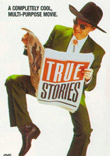TRUE STORIES - REVIEWS/PRESS

The New York Times
By Janet Maslin
David Byrne In 'True Stories'
Luckily, a lot of the small-town American artifacts David Byrne uses in ''True Stories'' already existed, so Mr. Byrne didn't have to invent them. But he easily could have, so perfectly do they follow from the sensibility he has displayed as the singer, songwriter and visionary behind Talking Heads. Mr. Byrne's music has always been uncommonly visual, and when he began directing rock videos he seemed to be making an effortless transition. The leap to feature film making comes even more freely: ''True Stories'' is a pure and jubilant extension of Mr. Byrne's distinctive world view.
''Although the name of the film is 'True Stories,' I am saddened and disappointed to have to admit that a lot of the stories are made up,'' Mr. Byrne writes in his author's note to the published screenplay. But he also closes the film with a title that reads ''If you can think of it, it exists somewhere,'' and that comes closer to defining the film's notion of veracity. The real world can be seen afresh when its simplest absurdities are regarded, as they are here, with naive fascination. And Mr. Byrne has that to spare. His presence here, as a ''friendly and straightforward'' (according to the screenplay) narrator, goes a long way toward giving the film its breezy, accessible tone.
A lot of ''True Stories'' derives from tabloid newspaper clippings Mr. Byrne collected, chronicling occurrences that are much stranger than fiction. These tales might be lurid in another setting, but Mr. Byrne prefers to marvel at them in a spirit of innocent good cheer. The town of Virgil, Tex., where the film is set, is replete with archtypical shopping malls, tract houses on the edge of nowhere, bars that serve drinks with umbrellas. Mr. Byrne, who cruises through Virgil in a red convertible and a greenish cowboy suit the color of electrified lichen, is on hand to savor every detail. ''When I see a place for the first time, I notice everything - the color of the paper, the sky, the way people walk, doorknobs, every detail,'' he says. ''True Stories'' makes its audience notice things in that way, too.
The film's more obvious inventions, like the fashion show featuring Astroturf suits for the entire family, are reasonably easy to spot. The characters Mr. Byrne has created, while amiably farfetched, recede more comfortably into Virgil's real-life absurdist landscape. There is a cute woman (Alix Elias), who sits in her frill-filled house wondering whether the world is getting cuter or uglier. The laziest woman in the world (Swoosie Kurtz), in her bedroom with its array of labor-saving gadgets, also broods on certain imponderables (''You know how hot dogs come 10 to a pack and buns in packs of 8 or 12? You have to buy 9 packs to make them match up! That's what I'm talking about!'') The lying woman (Jo Harvey Allen) claims, among other things, to have written ''Billie Jean'' and known the real Rambo, while the lonely Louis Fyne (made especially memorable by John Goodman), who keeps a ''Wife Wanted'' sign on his front lawn, is looking for love. The Culvers, Kay (Annie McEnroe) and Earl (Spalding Gray), are a proper-looking couple who communicate only by way of their children.
The events through which these characters wander have a festive air. There is the above-mentioned fashion show, plus a talent contest, with the denizens of Virgil leaping to the stage one at a time to lip-synch lines from the effervescent new Talking Heads song ''Wild Wild Life.'' There is a parade, part of Virgil's ''Celebration of Specialness,'' with lawnmowers and baby strollers and Shriners driving miniature cars.
Even the highway has a certain gaiety as Mr. Byrne describes the styles of various drivers (the ''slingshotter,'' the ''adventurer,'' the ''marshmallow,'' the ''nomad'' and the ''weaver''). If this all seems trivial, that's pretty much the point. Mr. Byrne explains, in his written introduction, that the film eschews anything resembling big issues, and that ''I deal with stuff that's too dumb for people to have bothered to formulate opinions on.''
''True Stories'' may well appeal more to those who don't know much about Mr. Byrne's music career than those who do. The soundtrack songs have the catchy simplicity of Talking Heads' most recent and least demanding compositions. And the film's imagery, expertly captured in bold, bright colors by Ed Lachman, will be even more striking to those who find it novel. The Texas plains make a startlingly barren backdrop to some of the objects Mr. Byrne studies (''Anything you stick in there is just about all there is to look at,'' he writes accurately of that landscape), and some of the film's montages perfectly encapsulate both Mr. Byrne's sophistication and his studiedly gee-whiz side. One standout sequence, which is bound to turn up as a rock video, mixes images of the group members with images of commercial products until the band members are dipped in chocolate and wrapped in tinfoil.
Back to Reviews
